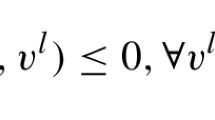Abstract
An approach to the sensitivity analysis for discrete optimization problems with perturbedobjective function is presented. The problem is stated in the following general form:minΣe∈Y c(e) : Y ∈ F, where c = (c(e), e ∈ E) is a vector of weights for some finite set E,and F ⫅ 2E is a given family of feasible subsets. It is assumed that the set of feasiblesolutions F is fixed, but the coefficients of the vector c may vary. The main problem consideredin this paper concerns the following question: How does the maximum relative errorof a given feasible solution depend on inaccuracies of the problem data? Two particularperturbations of the vector c are considered:(i) it is assumed that c is in a closed ball with radius δ≥0 and center c o≥0 or(ii) the relative deviation of c(e) from the value co(e) is not greater than δ for any e ∈ E, i.e.,|c(e) ‐ co(e)| ≤δ co(e), e ∈ E.For a given feasible solution X ∈ F , two functions of the parameter δ are introduced: thesensitivity function s(X, δ) and the accuracy function a(X, δ). The values of s(X, δ) anda(X, δ) are equal to the maximum relative error of the solution X when the perturbations ofproblem data are of the type (i) or (ii), respectively. Some general, but computationallyinefficient formulae for calculating these functions are derived and their properties arestudied. It is shown that s(X, δ) and a(X, δ) are nondecreasing, convex functions with alimited number of breakpoints. A practically efficient method of calculating upper and lowerenvelopes for the accuracy function is presented. This method is based on the notion of k‐bestsolutions of the problem. It gives an interval to which the maximum relative error ofthe solution X must belong when the coefficients of vector c are given with accuracy δ. Theapproach is illustrated with an example of the symmetric traveling salesman problem.
Similar content being viewed by others
References
A.M. Geoffrion and R. Nauss, Parametric and post-optimality analysis in integer programming, Management Science 23(1977)453-466.
H.W. Hamacher and M. Queyranne, K best solutions to combinatorial optimization problems, Annals of Operations Research 4(1985/6)123-143.
M. Labbé, J.F. Thisse and R.E. Wendell, Sensitivity analysis in minisum facility location problems, Operations Research 39(1991)961-969.
E.L. Lawler, A procedure for computing the K best solutions to discrete optimization problems and its applications to the shortest path problem, Management Science 18(1972)401-407.
E.L. Lawler, J.K. Lenstra, A.G. Rinnooy Kan and D. Shmoys (eds.), The Traveling Salesman Problem: A Guided Tour of Combinatorial Optimization, Wiley, Chichester/New York, 1985.
M. Libura, Integer programming problems with inexact objective function, Control and Cybernetics 9(1980)189-202.
M. Libura, Optimality conditions and sensitivity analysis for combinatorial optimization problems, Control and Cybernetics 25(1996)1165-1180.
M. Libura, E.S. van der Poort, G. Sierksma and J.A.A. van der Veen, Sensitivity analysis and the k-best solutions for the traveling salesman problem, Technical Report PMMiO-2/95, Systems Research Institute, Polish Academy of Sciences, Warszawa, 1995.
C.J. Piper and A.A. Zoltners, Some easy postoptimality analysis for zero-one programming, Management Science 22(1976)759-765.
R. Ramaswamy and N. Chakravarti, Complexity of determining exact tolerances for min-sum and min-max combinatorial optimization problems, Report No. WPS-247/95, Indian Institute of Management, Calcutta, 1995.
G. Reinelt, TSPLIB — A traveling salesman problem library, Report No. 250, Universität Augsburg, Institut für Mathematik, 1990.
Y.N. Sotskov, V.K. Leontev and E.N. Gordeev, Some concepts of stability analysis in combinatorial optimization, Discrete Applied Mathematics 58(1995)169-190.
G.R. Wilson and H.K. Jain, An approach to postoptimality and sensitivity analysis of zero-one goal programs, Naval Research Logistics 35(1988)73-84.
Rights and permissions
About this article
Cite this article
Libura, M. On accuracy of solutions for discrete optimization problems with perturbed coefficientsof the objective function. Annals of Operations Research 86, 53–62 (1999). https://doi.org/10.1023/A:1018991826728
Issue Date:
DOI: https://doi.org/10.1023/A:1018991826728



